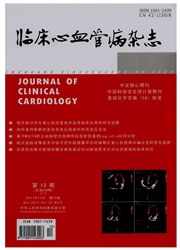

 中文摘要:
中文摘要:
目的:探讨中性粒细胞与淋巴细胞比例和孤立性心房颤动(房颤)射频消融术后复发的关系。方法:回顾分析119例行射频消融术治疗的孤立性房颤患者,阵发性房颤手术方式为环肺静脉电隔离,非阵发性房颤在环肺静脉电隔离基础上行线性消融,收集患者基本的临床资料、生化及物理检查指标。依据随访结果将患者分为复发组与未复发组,分析预测心律失常复发的相关危险因素。结果:随访14~27个月,平均(15.4±3.5)个月。共有38例(31.9%)复发。单因素分析显示,P〈0.1的指标有非阵发性房颤、左房前后径(LAD)、左房容积指数(LAVI)、房颤持续时间、三酰甘油、中性粒细胞与淋巴细胞比值(NLR)。对以上指标进行二分类反应变量的Logistic回归分析,结果显示,LAVI(OR=1.102,95%CI:1.017~1.195,P=0.018)、NLR(OR=4.433,95%CI:1.863~10.546,P=0.001)以及房颤持续时间(OR=1.019,95%CI:1.000~1.038,P=0.046)具有统计学意义。ROC曲线分析显示,LAD的界值点为40.5mm,LAVI的界值点为26.3ml/m2,NLR的界值点为1.64,房颤持续时间的界值点为11.4个月。Kaplan-Meier生存曲线显示,LAD≥40.5mm组与LAD〈40.5mm组(35.3%︰81.2%)、LAVI≥26.3ml/m^2组与LAVI〈26.3ml/m^2组(60.8%︰77.9%)、房颤持续时间≥11.4个月组与〈11.4个月组(46.2%︰94.8%)、NLR≥1.64组与NLR〈1.64组(52.9%︰79.4%)消融成功率比较均差异有统计学意义(均P〈0.05)。结论:LAD、LAVI、NLR、房颤持续时间是孤立性房颤射频消融术后房颤复发的独立危险因素,当LAD≥40.5mm、LAVI≥26.3ml/m^2、NLR≥1.64,房颤持续时间≥11.4个月时,复发的概率明显增加。
 英文摘要:
英文摘要:
Objective:To investigate whether neutrophil/lymphocyte ratio(NLR)could predicts lone atrial fibrillation(LAF)recurence after radiofrequency catheter ablation(RFCA).Method:A total of 119 patients with LAF after RFCA were enrolled.Bilateral circumferential pulmonary vein isolation(CPVI)was performed in paroxysmal atrial fibrillation(PAF),and CPVI combined with linear ablation was performed in non-PAF.The basic clinical data,biochemical and physical examination indicators were collected.Patients were divided into recurrent group and non-recurrent group according to follow-up results.Risk factors associated with arrhythmia recurrence were analyzed.Result:All patients were followed up for 14-27 months with an average of 15.4 ± 3.5months.Thirty-eight patients(31.9%)recurred.The single factor analysis showed that parameters with P value〈0.1were non-PAF,LAD,LAVI,AF duration time,TG and NLR.These above factors were included into binary Logistic regression analysis and the result showed statistical significances in LAVI(OR=1.102,95%CI:1.017-1.195,P=0.018),NLR(OR=4.433,95%CI:1.863-10.546,P=0.001)(OR=1.019,95%CI:1.000-1.038,P=0.046).The Roc cutoff point of LAD was 40.5mm,LAVI was 26.3,AF duration was 11.4months,and NLR was 1.64.Kaplan-Meier analysis showed statistically significant differences in LAD≥40.5mm and LAD〈40.5mm(35.3% vs 81.2%),LAVI≥26.3ml/m^2 and LAVI26.3ml/m^2(60.8% vs 77.9%),AF duration≥11.4months and AF duration〈11.4 months(46.2% vs 94.8%),NLR≥1.64 and NLR〈1.64(52.9% vs79.4%)(all P〈0.05).Conclusion:LAVI,LAD,AF duration time and NLR are independent risk factors thatcould predicted the recurrence of LAF after RFCA.When LAD≥40.5mm,LAVI≥26.3ml/m^2,AF duration≥11.4months and NLR≥1.64,the recurrent rate may be significantly increased.
 同期刊论文项目
同期刊论文项目
 同项目期刊论文
同项目期刊论文
 期刊信息
期刊信息
